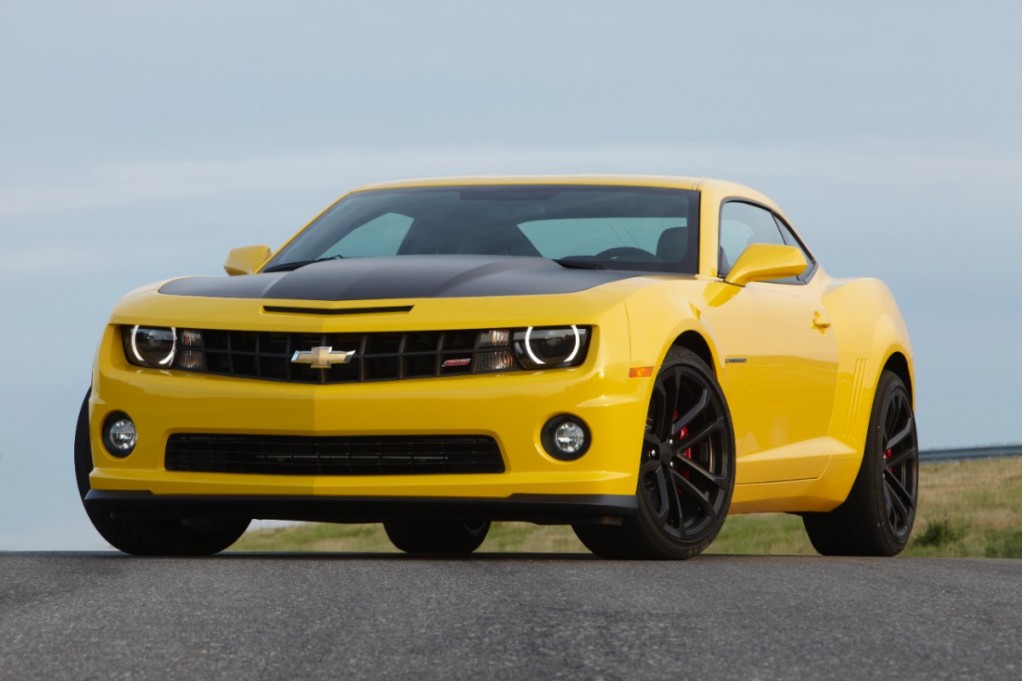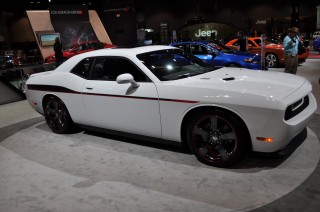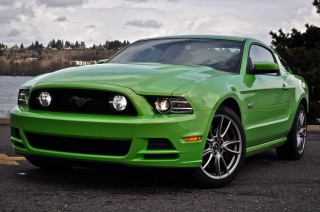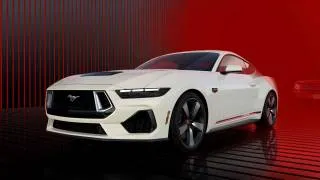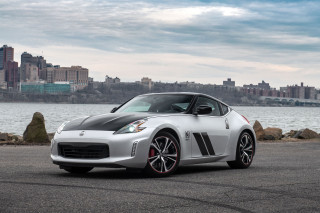Likes
- Classic but contemporary looks
- • EPA estimated 30 mpg highway for base engine
- Balanced handling gets better with 1LE
- Rides well, even with big 20-inch wheels
- More connectivity and features than ever
Dislikes
- Visibility an issue even in convertibles
- There's not enough head room
- There's not enough rear-seat leg room
- Interior's better, but still a weak point
Buying tip
features & specs
The Chevy Camaro's no single-minded musclecar--there's good gas mileage and entertaining handling to be had, if you tick the right boxes.
Now in its fourth year since its rebirth, the Chevrolet Camaro's finally fleshed out almost all of its potential. Chevrolet offers something for everyone with its coupe and convertible Camaros, from base LS models to the king of smoky burnouts, the ZL1.
This year's lineup includes four or five trims, depending on how you count them: LS, LT, SS (and its 1LE sub-trim), and ZL1. They share some common cheekbones: that rock-'em, sock-'em styling that's beyond polarizing. If it's what an eighth-grader would draw if they could draw the next Camaro, so be it: every inch of sheetmetal is outrageous, from its too-low roofline to its squared-off haunches. The cockpit's less so, but SS and ZL1 trims can be fitted with suede, leather, and brightly colored accent pieces.
The stock Camaro V-6 boasts 323 horsepower with a choice of six-speed manual and automatic transmissions. It's the foundation for greatness, and in truth, it doesn't fare too badly as a sports car. It's quick enough to 60 mph to earn the name, and the combination of rear-wheel drive, electric power steering, and an independent suspension yield a comfortable ride and reasonably nimble responses. An EPA rating of 30 mpg highway might actually overshadow this version's performance credentials.
Still, it's the V-8-powered Camaro that draws almost everyone into the whole notion of owning Chevrolet's pony car. It 6.2-liter engine sings a lyrical note that's hypnotic to men of all ages. We're looped by it too—and by the rocket-like runs to 60 mph of 5 seconds or less. There's ample room for improvement over the base SS and its tendency to understeer (encouraged by it's the huge 20-inch staggered tires matched to front-end weight bias)—and the cure's found in the new 1LE package: it rights the tires to equal dimensions, tightens up the steering and manual gear ratios, and lets loose with easy, controllable oversteer much sooner in the Camaro's cornering calculus.
There's another development, way up on the price and performance ladder: the ZL1, in coupe and convertible forms. They're strapped to a supercharged, 580-horsepower version of the same engine, available with either transmission, and fitted with the same magnetic shocks you'll find in the Corvette and some Cadillacs. Zero to 60 mph times drop to 3.9 seconds, while top speed floats to a supercar-style 184 mph. It's almost beyond the reach of the Camaro nameplate, overlapping the stock 'Vette by a good margin except in price—still about $60,000.
No matter which Camaro you choose, the pitfalls are common. The low, sleek roofline is tight around tall drivers and its high beltline makes it difficult to see out of the car for shorter ones. Its back seat is suitable only for children and its trunk is diminutive.
Safety and convenience features abound, and the NHTSA rates the Camaro coupe at five stars overall. Features are also ample, with OnStar standard, newly available navigation, Bluetooth, USB input, iPod connectivity, and a head-up display that mimics the one found in the Corvette. The convertibles is fitted with a power-folding soft top with a glass window and a rearview camera as standard. The ZL1 is the instantly collectible bundle—but make no mistake, even SS models, especially 1LEs, have the potential to interest auctioneers in years to come.
2013 Chevrolet Camaro Styling
We get and enjoy the Camaro's cartoonish musclecar looks, but the cockpit's not in sync.
The styling of the Chevy Camaro isn't polarizing—it's exaggerated for sure, but if you don't like it, you didn't want one anyway.
We're fans of the Camaro's retro-tinged look, filtered as it is through a modern lens. That doesn't leave it free of criticism. There's a bold face, squat haunches, and muscular fenders all heady and evocative of the best Camaros of the past. The front end's a bit bluff, though, and the roofline and glass areas are small, especially when the Camaro's caught from a pure side view. It's all too much to digest in one look--the way really exciting cars should be.
The design hasn't changed much since its introduction just a few years ago, though the new ZL1 adds some serious aggression to match its raised performance, as does the 1LE package--both with their own aero additions, splitters, two-tone treatments, and even more hulking appearances.
Inside, the Camaro's cabin receives retro-themed touches than its sheetmetal; nods to Sixties sleds are mostly found in the Camaro's low-mounted console gauges, nested bezels, and vintage type face. Despite the retro nods and gradual improvements in materials, the Camaro's interior isn't quite as useful or as well-finished as the cockpits in some other sporty coupes in the same price range, like the Hyundai Genesis Coupe, or even the Ford Mustang.
2013 Chevrolet Camaro Performance
No matter which Camaro you choose, you'll be rewarded with quick, relatively nimble performance--but not all Camaros are alike.
The Chevy Camaro is a performance story in three parts: six-cylinder cars of surprising strength and good fuel economy are the opening act, while the breathtaking SS and 1LE V-8s propel the story at a blinding pace. Then, just when you think you've figured it all out, the ZL1 sends the whole thing off in a new, expensive, faintly exotic direction that might leave you wondering, what the hell just happened?
The standard LS and LT coupes and convertibles kick things off with a 323-horsepower 3.6-liter V-6. If you've blotted out a six-cylinder Camaro from your memory because of Berlinettas past, it's time to reconsider. This Camaro can rip off 0-60 mph times of about 6 seconds, whether you choose the meaty six-speed manual or the six-speed automatic. It's not the most mellifluous sound in the world—don't listen to the V-8s if you have any hope of escaping the showroom for under $30,000—but the V-6's acceleration is not its black mark.
Handling isn't either. Nimbleness is delivered through its standard 18-inch wheels via control-arm and coil-over shock rear suspension matched with an electric power steering system that doesn't feel too artificial. Turning up the dial is an available sport suspension package on the base Camaro, especially considering its 3,800 pounds of heft. Ridding the Camaro of its top means losing some of the precise feel enjoyed in the coupe. But reset your expectations if you last drove a Camaro when Hammer Pants weren't worn ironically; a vast gulf exists between the modern base model and even the last generation's high-performance models.
And if the V-6 introduces a gulf, V-8 models flood it into an ocean. The 6.2-liter Camaro SS emits the rumble every muscle-car driver craves—with significant handling improvements over the V-6, depending on your choice of suspension, steering, and wheel-and-tire packages. The throaty V-8s—yes, two of them—are paired to manual and automatic six speeds. The 426-horsepower V-8 is fitted exclusively to cars with manual transmissions; expect a horsepower decrease if you want to leave cog-swapping duties to the automatic, as those models are powered by a 400-hp version of the same engine. Chevrolet attributes the power loss to the automatic's fuel delivery system. Regardless, 60 mph is achieved in about 5 seconds with all the fury and theatre associated with a 6.2-liter lump. While six-cylinder models work just fine with the available automatic, you're selling yourself short by opting for the slushbox in the SS as its manual shifter is a well ironed-out piece with short throws and quick shifts. As a bonus to rowing your own, manual models open their throats at full trot via a dual-mode exhaust system. That exhaust trickery isn't even an option with the automatic transmission.
But wait! That's not all! Chevrolet splits the V-8 into separate sub-models. All utilize a similar suspension setup, 20-inch alloy wheels, and electric power steering, but its this year's new 1LE that takes the handling cake.
The basic SS coupe wears staggered 245 front/275 rear tires. With the Camaro's short wheelbase and wide stance, the combined recipe produces understeer isn't near as chuckable as one would think of a car with this much available power going to the rear wheels. On the plus side, SS models and V-6s equipped with the optional sport suspension setup produce a better ride than expected.
Still, the SS isn't a track monster—at least, not until now. The SS 1LE cures nearly all with track ready, neutral handling out of the gate. From our experience testing it on Gingerman Raceway in Michigan, the 1LE tweaks may as well be the stock suspension on all SS models. The upgrade changes the SS significantly with a closer-ratio manual transmission (sorry, no automatic here) and 35-series tires of the same width front and back. A front strut brace, larger front anti-roll bar, monotube rear shocks, and suspension mounts borrowed from the ZL1 improve the Camaro's stability. The package is fitted to the less plushly trimmed SS for some weight reduction, and it also gets a blacked-out hood and spoiler, along with transmission cooling. It's a revelation to drive a 1LE and expect tons of push: it doesn't. With stability control set to a sport mode that allows some yaw, the 1LE gently steps out into oversteer, corrected easily with remapped variable-ratio electric power steering that's another one of GM's well-tuned efforts. It's possible to option up an SS to near 1LE-spec--but the steering is one piece that's otherwise unavailable. We haven't driven one on public roads, but a 1LE in the right context--on a road course--acquits itself with disinctly un-muscle-car moves.
Above all other comers, the Camaro's final act is the most difficult one to reconcile. It's because it's more of a supercar than a Camaro, with a pricetag in the $60,000 range to match. The ZL1 supercharges the SS's 6.2-liter V-8 for a grand total of 580 horsepower, and adopts magnetic dampers and a host of aero body pieces (the hood has a carbon-fiber insert) to cope with the copious upgrade in power. Its 0-60 mph time is pegged at 3.9 seconds, and top speed hits 184 mph--and Chevy's lapped the Nurburgring in less than eight minutes in a coupe, all figures that suggest Corvette until the cover's pulled off the body.
That's part of the mind-twist the ZL1 represents. Is it still a Camaro if it only looks like one? With its unreal performance comes some expensive and single-use add-ons--a launch-control mode, a differential cooler, distinct links for the rear anti-roll bars, the dual-mode adjustable suspension--the ZL1's more a rolling experiment lab for what the Camaro can be when it cribs Corvette parts. It's also an instant collectible, whether a coupe or a convertible. And it's a prodigious consumer of rubber whether all its electronic traction aids are turned on or off--you'll just measure the loss of tread visibly with all of those helpers shut down, as you also watch the effects of supercar power lose the battle with physics, time and time again.
2013 Chevrolet Camaro Comfort & Quality
Chevy's gradually improved the Camaro's interior, but headroom is tight, and the rear seats and trunk are very small.
The Chevy Camaro pays an obvious price for its meta-Sixties sheetmetal. The interior's small even by musclecar standards, and storage and trunk space are minimal.
Taller drivers get the worst of it in the Camaro, and those that race will feel it every time they strap on a helmet. The front seats--from base models to the sporty seats on ZL1s--are comfortable even for long trips. There's simply not enough headroom for six-footers, especially when a sunroof is part of the equation. Then, the low roof loses all its clearance, and the Camaro comes up short. Even getting in and out of the car can be difficult, with the roofline and long, heavy doors stretching the boundaries of convenience.
The rear seats are 911-like, which is to say, almost unusable for anyone beyond their single-digit years. There's simply not enough leg room here even for tweenagers--just under 30 inches of leg room by the spec sheet. The interior also narrows dramatically as the Camaro swells around its wheels at its hips. The trunk struggles to swallow tennis bags, and the cockpit doesn't offer much in the way of storage.
With more expensive models, the Camaro's interior livens up. It's been a sore point since the latest car was introduced in 2010: the look doesn't match the retro sheetmetal, and much of it is covered in dull, grainy plastic. It's improved over time, and the introduction of Color Touch radios glams up the center stack a lot, as do the suede finishes on the ZL1 and the brightly colored trim pieces inside the Camaro SS.
Despite these complaints, everything appears to be well-assembled, with no squeaks, creaks, or rattles intruding on the experience. Cabin noise in general is of the kind we like, and tire and wind noise are kept to a minimum.
2013 Chevrolet Camaro Safety
The NHTSA gives the Camaro coupe top scores; rearview cameras and Bluetooth should be on all buyers' shopping lists.
Some crash-test scores are lacking, but the available data show the latest Chevy Camaro to be more crashworthy than any before it--and better than some best-selling sedans.
The National Highway Traffic Safety Administration (NHTSA) rates the Camaro coupe at five stars overall, an excellent score for a sporty car. However, it hasn't yet tested a convertible--and the Insurance Institute for Highway Safety (IIHS) hasn't tested any Camaro at all.
The usual safety features are standard in the Camaro, from six standard airbags, to anti-lock brakes and stability control, to GM's OnStar telematics system, provided with six months of emergency service.
Visibility is a liability in the Camaro. The Camaro's high beltline hinders visibility for drivers of more normal height, all the more so for shorter drivers. Rearward visibility is compromised for all drivers with thick rear roof supports and a small rear window. The Camaro lacks a standard rearview camera and parking sensors--items it sorely needs, given the horrible rearward visibility induced by its coupe body style. They're unavailable on the LS coupe, and optional on the next trim level up, but standard on convertibles.
Bluetooth is an option on some models as well. We think, given the prevalence of mobile phones, it's a necessity.
GM redesigned OnStar's buttons and the Camaro's rearview mirror this year, going to a frameless design that creates a little more viewing area. Any little bit counts in this case, as the Camaro's rear glass and side mirrors are exceptionally small.
2013 Chevrolet Camaro Features
Navigation, new radios and a frameless mirror hustle the Camaro even more quickly into the modern world.
The Chevy Camaro doesn't dwell in stripperville. Even the base versions carry enough features to please today's enthusiasts and tomorrow's collectors, and this year the Camaro makes strides in catching up to the Mustang's more complete list of options.
The lineup includes the Camaro LS, LT, SS, and ZL1. All versions, including the base LT, come with power windows, locks, and mirrors; air conditioning; cruise control; 18-inch wheels; a rear spoiler; Bluetooth; an AM/FM/CD player with satellite radio and an auxiliary jack; and steering-wheel controls. OnStar telematics service is also included, free of charge, for six months.
Options on some models include remote start; leather-wrapped steering wheel and shift knob; ambient lighting; a USB port; and on coupes, a sunroof.
On all convertibles (LTs and SSs and ZL1s), there's a power-operated fabric roof with a glass rear window; a rearview camera; and Chevy's new Color Touch radio, which also is found on LS and higher coupes.
Color Touch provides a graphic interface on an LCD touchscreen for direct control of audio and phone features, and also runs the Camaro's newly available navigation system--a first for the muscle car. It also connects the car's audio system to smartphones and enables some mobile apps for in-car use, apps like Pandora, and also accepts voice commands for audio, phone and navigation--though it's not quite as flexible or as vocabulary-rich as Ford's system, for example.
From some LT trims and up, the Camaro adds more luxury features, like power-recline front seats; heated and leather-trimmed seats; a head-up display; premium audio; and a three-spoke steering wheel. An RS package gets its own body kit and 20-inch wheels.
The Camaro SS 1LE is treated as an option package, but gets its own suspension design and 20-inch wheels and tires front and back, along with a manual transmission, a matte-black hood and spoiler, a front air splitter, and a flat-bottom steering wheel. See our performance section for a more thorough discussion on it and for the ZL1 and its mechanical differences.
The ZL1 makes almost all available features standard, and gets its own wheel and color choices, along with its own aero-add ons; suede interior trim; alloy pedals; rear parking sensors; a set of four ancillary gauges; and standard remote start on automatic-equipped models. A suede package for the interior and a sunroof are among the few options.
2013 Chevrolet Camaro Fuel Economy
If you're looking for an efficient Camaro, the V-6 is the best choice; V-8 versions aren't bad, given their extreme horsepower.
Musclecars can give the impression of poor fuel economy on looks alone. For some versions of the Chevy Camaro, that's simply not the case.
The V-8-powered SS and ZL1 Camaros won't bring home any awards for saving the planet, though they're fairly efficient for their enormous power ratings. The V-8 SS scores just 15-16 mpg city and 24 mpg highway, depending on the transmission chosen, for example.
The ZL1's prodigious 580-horsepower output results in fairly low gas mileage ratings: the EPA pegs the manual at 14/19 mpg and the automatic at 12/18 mpg, no matter which body style is chosen.
The V-6 Camaro, though, does very well, given the car's sporty nature. When equipped with the six-speed automatic transmission, the coupe rates as high as 19 mpg city and 30 mpg highway, with manual-transmission models earning 17/28-mpg ratings.
